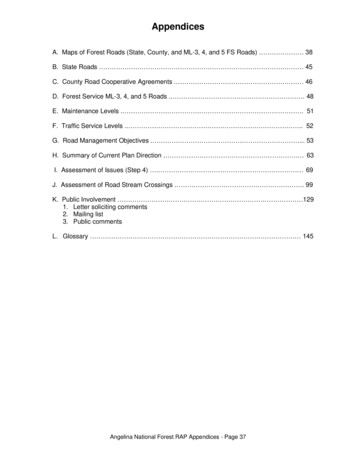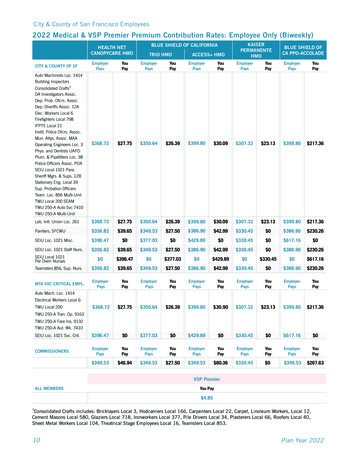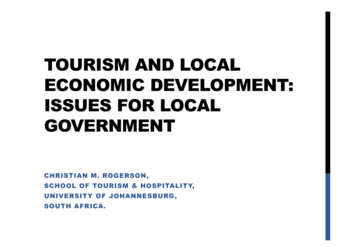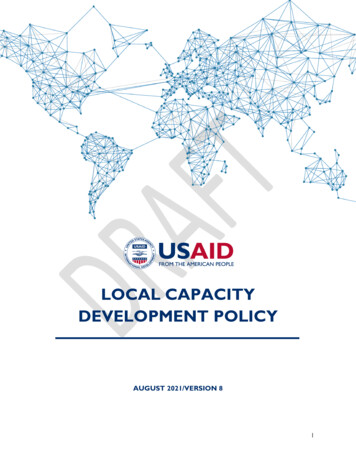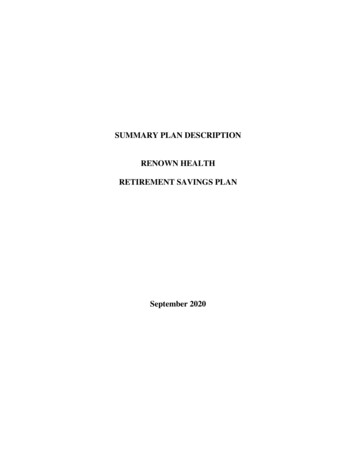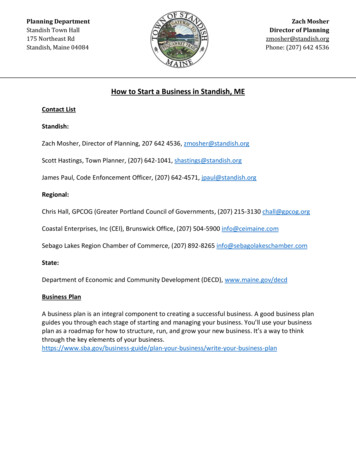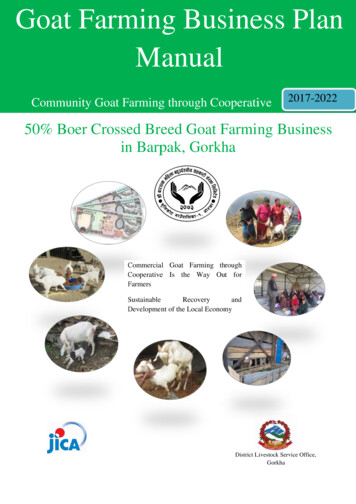
Transcription
LOCAL DEVELOPMENTBUSINESS PLAN2018EAST BAY COMMUNITY ENERGYCLEANER ELECTRICITY. COMMUNITY BENEFITS.
EAST BAY COMMUNITY ENERGYLOCAL DEVELOPMENT BUSINESS PLANContents1)EBCE and the LDBP12)CEO Message23)LDBP Executive Summary44)LDBP Introduction95)Section I: Early Actions for Local Development146)Section II: Supporting Resources, Policies, & Strategies347)Section III: Ongoing Analysis, Implementation, & Refinement 688)LDBP Implementation Timeline809)LDBP Conclusion8310)Glossary of Key Terms8411)Index of Underlying LDBP Background Documents8612)Acknowledgements87
LOCAL DEVELOPMENT BUSINESS PLANEAST BAY COMMUNITY ENERGYLeadershipEBCE& the LDBPWhat is EBCE?East Bay Community Energy, also known asEBCE, is a new Community Choice Energy Agencyserving Alameda County. EBCE will providecleaner, greener energy at lower rates and otherenergy services to the East Bay community.EBCE will reinvest earnings back into the community to create local green energy jobs, localprograms, and clean power projects. As a not-forprofit public agency, EBCE is accountable to itscommunity and customers, not shareholders.VisionEBCE seeks to deliver economic, environmental,and social benefits to the communities ofAlameda County by providing cleaner electricityat competitive rates, developing local resourcesthat drive new investments, and creatingincreased demand for high-paying jobs. EBCEwill offer carbon-free energy with solar, wind,and hydropower sources. Over time, EBCE willincrease the amount of solar and wind in thepower mix as the community moves towards100% renewable energy.The East Bay Community Energy Board ofDirectors comprises elected officials from eachof the 12 participating jurisdictions and one(non-voting) representative from the CommunityAdvisory Committee (CAC). The EBCE Boardmeets once a month and all meetings are opento the public. The CAC consists of nine membersappointed by the EBCE Board of Directors. TheCAC acts as a liaison between the communityand the EBCE Board, holding public committeemeetings on a regular basis.Commitment to Clean EnergyAt EBCE, providing cleaner, greener energy atlower rates to customers is a top priority. Gettingelectricity from EBCE is a simple way to reducegreenhouse gas (GHG) emissions and meet local,state, and national climate action goals. As EBCEbegins serving customers in 2018, it will launchwith an ambitious power mix goal with higherpercentages of renewable energy than PG&E.EBCE will also offer an opt-up premium productfor customers who want to double-down on environmental protection and power their homes orbusinesses with 100% carbon-free energy. EBCEis also committed to investing in efforts to createmore local sources of renewable energy. This willsupport local job creation, and help to build a moresustainable future for the EBCE community.Local Development Business PlanThe Local Development Business Plan (LDBP)is intended to develop a comprehensive framework for accelerating the development of cleanenergy assets within Alameda County. The LDBPexplores how EBCE can contribute to fosteringlocal economic benefits, such as job creation,customer cost-savings, and community resilience. The LDBP also identifies opportunities fordevelopment of local clean energy resources,explains how to achieve EBCE’s communitybenefits goals, and provides strategies for localworkforce development for adoption by the EBCEBoard of Directors.1
2EAST BAY COMMUNITY ENERGYLOCAL DEVELOPMENT BUSINESS PLANCEO MessageThis Local Development Business Plan represents the beginning of East Bay CommunityEnergy’s (EBCE) journey to deliver the benefitsof clean energy to Alameda County. The Plan isstructured around a series of early actions thatcover a broad set of local clean energy solutions. The Plan also lays out a set of communitybenefit metrics - jobs created, energy costssaved, GHG emissions reduced - that serve asa framework for assessing the impacts of localclean energy options. Finally, the Plan describesa process for on-going community engagementfocused on setting EBCE’s local clean energypriorities based upon the measured impacts ofthe Early Actions.The Plan itself is purposefully not completebecause EBCE is itself still a work in progress.Instead, the Plan is a framework for EBCE tobroadly invest in a diverse set of local cleanenergy solutions and use the results of theseinvestments as the basis for setting EBCE’slonger term business plan. As EBCE buildsorganizational capacity, solidifies its financial position and establishes a track recordof delivering lower cost, cleaner energy to itscustomers, the outputs of this Plan will provideEBCE with real world proof points of whatlocal clean energy solutions are best suited todeliver the most impact. This in turn will allowEBCE to develop a follow up to the Plan with afocus on scaling up local clean energy development in those areas that have demonstratedthe most actual potential for impact.From EBCE’s formation onwards, it has been clearthat the residents of Alameda County want EBCEto move as quickly as possible to start deliveringlocal clean energy solutions. Finding the balancebetween early action and organizational development - or said another way - investing directly inAlameda County or in building EBCE - has beenone of my greatest challenges since I joinedEBCE. I believe that this Local DevelopmentBusiness Plan does an admirable job of findingthat balance. Most importantly, the Plan recognizes that on-going community engagement andpriority setting are the key to EBCE’s success indelivering local clean energy solutions.The completion of this plan is the starting pointof EBCE’s local clean energy journey. As EBCE’sembarks on this pathway, I want to make a specialacknowledgement to community members whohave spent countless hours advocating first forthe formation of EBCE and, most recently, for theLocal Development Business Plan.Thank you for joining EBCE as we work to supportAlameda County’s clean energy transition.– Nicolas Chaset, CEO
LOCAL DEVELOPMENT BUSINESS PLAN“This Local DevelopmentBusiness Plan representsthe beginning of East BayCommunity Energy’s journeyto deliver the benefits of cleanenergy to Alameda County.”– Nicolas Chaset, CEOEAST BAY COMMUNITY ENERGY3
4EAST BAY COMMUNITY ENERGYLOCAL DEVELOPMENT BUSINESS PLANLDBP Executive SummaryIntroductionThe East Bay Community Energy (EBCE) Local Development Business Plan (LDBP) is intended to supportthe achievement of a bold vision for implementing a Community Choice Aggregation (CCA) program inAlameda County, with a strong focus on developing local clean energy assets and maximizing local environmental, economic, and social benefits. It seeks to do this by providing a comprehensive framework forrapid deployment of beneficial clean energy programs and resources throughout the EBCE service territory.The LDBP identifies short-term, no regrets opportunities, as well as some of the tradeoffs betweenvarious local development goals. It also maps out a path to pursue and accelerate achievement of thosegoals (including economic and workforce benefits), while maintaining enough flexibility to adapt tochanges in state policy and regulation. In addition, it identifies innovative win-win strategies, programs,and mechanisms to create good jobs, provide programs that enhance economic equity, stimulateeconomic development, and accelerate the integration of local distributed energy resources (DER) inways that enhance EBCE’s long-term stability and reliability as an agency that the Alameda Countycommunity will depend on for years to come.Ultimately, the LDBP is an ambitious and exciting plan because it seeks to strike a balance between thepragmatic and the visionary. This plan translates the aspirational vision for EBCE into feasible, step-bystep recommendations for implementation. It is a roadmap for demonstrating what is possible whenthe community takes control of its own energy procurement and prioritizes delivery of local benefits inaddition to maintaining financially stable operations.Goals and Priorities for EBCE6 } ( 6 6 local benefits is highly important to the EBCE community.6 to EBCE’s long-term stability and success as an organization. I Overarching Goals and Objectives of the LDBP6 nity benefits using the Community Choice Aggregation mechanism.6 community and organizational benefits.6 } ( 6 local clean energy investments.6 6 greater community benefits than rate savings alone.
LOCAL DEVELOPMENT BUSINESS PLANEAST BAY COMMUNITY ENERGYCentral LDBP Concepts and Strategies6 } and a phased-in approach will support successful, cost-effective implementation of the plan.6 } data management practices, and ongoing data analytics.6 } Q } ( R 6 Q R I I Q ĉ R cial impacts, constrain costs, and minimize risks associated with LDBP implementation.6 1 ( } ( and surplus revenues can provide a wide range of important benefits to EBCE and its customers.6 } beneficial partnerships and outcomes.Recommended Suite of Early Actions for Local DevelopmentThe resulting business plan makes a series of recommendations for a sequential approach to feasibleand fiscally responsible implementation of the LDBP. The initial focus of the LDBP is on a set of earlyactions to be implemented in 2018 through 2020. The LDBP also provides a framework and iterativeprocess to continually guide EBCE’s local investments as it scales up its local development efforts in2020 and beyond.The LDBP recommends that EBCE implement the following projects and programs as early actionsdesigned to accelerate beneficial local clean energy development in Alameda County:1. Demand Response (DR)- The LDBP recommends conducting an early stage pilot project designedto test innovative applications of Demand Response programming in the CCA context that yieldmutually beneficial outcomes for EBCE and participating customers.2. Energy Efficiency (EE)- The LDBP includes a strategic approach to developing EE programing thatcreates synergy with established EE Program Administrators and community benefit organizationsby leveraging customer data to significantly increase participation levels in existing EE programs.3. Building Electrification- The LDBP recommends that EBCE develop an innovative approach to} Q I R bonization through permanent natural gas demand destruction.ĉ Transportation Electrification- It is recommended that EBCE pursue grant funding and external 1 vehicle electrification, to determine the costs and benefits, and to provide a solid foundationfor implementation of a programmatic approach to fleet electrification that delivers lasting andsubstantial local benefits.5. Collaborative ProcurementI } I the LDBP recommends a comprehensive program for working collaboratively with local governmentagencies, school districts, nonprofit organizations, as well as residential and nonresidential customersto develop beneficial clean energy projects that achieve lower costs through combined economiesof scale. The following applications of the Collaborative Procurement program are recommended asinnovative and feasible options for EBCE to pursue in the early stages of LDBP implementation.5
6EAST BAY COMMUNITY ENERGYLOCAL DEVELOPMENT BUSINESS PLANa. Municipal Feed-In Tariff (“MuniFIT”)- A hybrid of the Collaborative Procurement and Feed-in Tariff(FIT) programs recommended by the LDBP Consultants, this approach would involve workingcollaboratively with EBCE’s member jurisdictions to identify optimal sites for commercial-scalefront-of-the-meter (FTM) renewable energy and energy storage development through a facilitated process that lowers the collective system costs for all participants. As a starting point, theLDBP recommends focusing the implementation of a Feed-In Tariff on supporting these municipal projects, whereby EBCE would provide a standardized offer (i.e., FIT) to purchase the powerproduced by those systems at a favorable rate that benefits participating jurisdictions.b. Community Shared Solar PilotI } ĆIĉ able energy projects that use innovative ownership models, which will allow EBCE to evaluate thereal-world outcomes from new approaches to financing and ownership that create a pathway toequity for local businesses and residents who may have barriers to entry into the beneficial renewableenergy generation market. This is another appropriate application of the Feed-in Tariff, as providing astanding offer can overcome market barriers that have slowed these projects. The pilot project wouldalso benefit from grant funding to achieve a greater scale, enabling EBCE to support the developmentand evaluation of additional projects, each with different approaches to the ownership model.c. Community Net Energy Metering Pilot (“CNEM”)- EBCE can test the potential for a collaborative) * I I Q} R 1 at a greater scale that reduces costs, by partnering with one or more renewable energy developers.d. Direct RE Contracting for Large Customers Pilot- The LDBP recommends that EBCE seek grantfunding to develop an initial pilot that applies a Collaborative Procurement model to other largecustomer segments (i.e., school districts, government agencies, commercial and industrial accounts,etc.), which could provide similar benefits to those customers as Direct Access (DA) contracting andhelp reduce opt-outs of these valuable customers if the DA market is expanded in the future.e. Utility-scale Renewable Energy & Storage- The LDBP recommends strategies for soliciting utilityscale wind, solar, and energy storage through wholesale procurement and competitive solicitationsfor new construction of in-county resources in collaboration with established, credit-worthyentities to overcome the early lack of EBCE credit rating.6. Enhanced Net Energy Metering (NEM)- The LDBP recommends an innovative NEM structure thatseeks to incentivize local renewable energy and energy storage deployment in ways that overcomemarket failures and barriers, enhance the value of NEM to EBCE, and maximize community benefitsachieved through the program.7. Community Investment Fund- A new approach to directly supporting community innovations andlocal development is recommended by the LDBP, which involves setting up an internal, revenuesupported fund for providing grant funding to local governments, workforce training organizationsengaging disadvantaged workers, community organizations, and entrepreneurs who are working on 1 } ( LDBP Implementation TimelineThe Local Development Business Plan project was envisioned to support EBCE’s bold vision for accelerating local development of clean energy resources to maximize community benefits in the early years ofEBCE’s existence. The recommended timeline (detailed in Figure 1) includes a significant number of earlyactions, which EBCE’s Board and staff have already begun to implement. The timeline also indicates therecommended steps for assessing, refining, and updating the plan through a transparent, inclusive, anditerative public process using the tools and frameworks developed during the preparation of the LDBP.
LOCAL DEVELOPMENT BUSINESS PLANEAST BAY COMMUNITY ENERGY Organizational Development: ( # . ( " ! # ' - 2 . Enhanced Net Energy Metering (NEM) Continue Implementation of Stage 1 Programs . % - . ( !" ( *#!. . - " ! (staffing, data, etc.) Collaborative Procurement Program ( 5 3 %(0” ( " / / . ( " , . # 5 " . (for large accounts) 2 5./ . ( - " ( (OCEI) Implement Demand Response Pilot Mid-term Assessment of LDBP ProgramPerformance & Outcomes 1 *#!. 0 % (i.e., IMPLAN) " 0 . 5 Ongoing Facilitated Stakeholder Engagement * !" / " " 2 & !" ! " - 1 *#!. / 0 ( / 4 *#!. ( Develop Building Electrification Program Implement Transportation Electrification Pilot Promote & Enhance Existing Energy Efficiency Community Investment Fund ( & & ( & " ( & " "" Comprehensive Assessment ofLDBP Programs & Outcomes: 5 ( " / ( ) ( ( 0 . 5 Expand & Refine LDBP Metrics 1 st Major Update to the LocalDevelopment Business Plan . . ( , . ( *#!. ( % 0 Ć } Ĉ Ċ } LDBP Performance MetricsThe LDBP includes a set of impact metrics to estimate and track the performance of LDBP programs and those metrics and estimate LDBP outcomes under user definable scenarios (see Figure 2). An initialscenario analysis was conducted to support the development of this Plan, and subsequent analyses canbe conducted to gauge the pros and cons of various investment options and program design parameters,engage the community in the planning process, and inform EBCE’s local development priorities withdata-driven insights. This approach to using the tools and frameworks developed for the LDBP projectunderpins the ongoing, inclusive, and iterative implementation process recommended in the LDBP.CategoryPerformance Metric (Units)Direct Annual Jobs CreatedFull-time Equivalents (FTE's)Labor Wage ImpactsDirect Job Wages ( ’s/hour)Fiscal ImpactsCosts ( ’s spent), Cost Savings ( ’s saved), Surplus Revenue ( 's/year)Customer Cost Savings ’s saved (Total and by Customer Class)Local Energy GenerationGWh’s Generated per YearGHG Emission ReductionsCriteria Air Pollution ReductionsMetric Tons of CO2e (MTCO2e) reduced, GHG Intensity (MTCO2e/MWh)Metric Tons (MT) of Criteria Pollutants reducedFigure 2: Overview of Performance Metrics for estimating and assessing LDBP impacts using the tools and frameworks developed for the LDBP.7
8EAST BAY COMMUNITY ENERGYCommunityChoice Aggregation“. a tool to accelerate the transitionto clean energy and pursue othercommunity priorities like localeconomic and workforce development”LOCAL DEVELOPMENT BUSINESS PLAN
LOCAL DEVELOPMENT BUSINESS PLANLDBPIntroductionCommunity Choice Aggregation (CCA) has beenpromoted as a mechanism to use energy procurement to pursue community priorities that maydiverge from the priorities of Investor-ownedUtilities (IOU). Many CCA advocates and communities in California see CCA as an effective tool foraccelerating the transition to clean energy and toachieve community benefit goals like climate andenvironmental protection and local economic andworkforce development.In Alameda County, the Joint Powers Agreement(JPA) that established East Bay CommunityEnergy (EBCE) included language to ensure thatthese goals would be pursued up front and begrounded in the operations of EBCE, rather thanremaining aspirational. To determine how toimplement these goals in a feasible and costeffective way, the JPA called for the preparationof a Local Development Business Plan (LDBP). Theresulting LDBP is designed to cover the first fiveyears of EBCE operation, providing a frameworkand roadmap for developing and procuring localenergy resources, and providing a descriptionof how EBCE will foster local economic benefits,such as job creation and innovative communityenergy programs.A feasibility study completed before issuing theRequest for Proposals (RFP) for the LDBP demonstrated that the Alameda County CCA could meetenvironmental and economic goals includingcompetitive electric rates, greenhouse gas (GHG)reductions, higher renewable content than PG&E,while providing a range of meaningful communitybenefits. The purpose of the LDBP has been tofigure out exactly how to make that happen—tomove from the conceptual to the operational.EAST BAY COMMUNITY ENERGYThe following paragraphs from the LDBP RFPdescribe this vision:“As the Community Choice process inAlameda County has evolved over time,many local officials and stakeholders haveexpressed a desire for EBCE to act upon astrong commitment to the development oflocal renewable energy resources as the wayto achieve a host of program goals relatedto greenhouse gas reductions, businessdevelopment, job creation and ratepayersavings and local wealth generation.This kind of robust local developmentrequires a transition over time from simplyprocuring renewable electricity on thewholesale market to creating an optimizedsystem of local distributed energy resources(DER) that play a larger and larger rolein addressing the energy needs of ourcommunities. But this transition doesnot happen by accident; the fundamentalchallenge is to set out a roadmap formaking it happen within an aggressive yetachievable timeframe.”In support of achieving the vision identifiedin the JPA Agreement and the LDBP RFP, thisLocal Development Business Plan includes thefollowing:1. A description of how EBCE will contribute tofostering local economic benefits, such as jobcreation and community energy programs.2. Opportunities for local clean energy development and innovative approaches to localprogramming that can help EBCE achieve thestated goals.3. Employment and labor standards that relateto the execution of EBCE energy programs.ĉ including the identification and explanation ofthe sources of electricity procured by EBCE.9
10EAST BAY COMMUNITY ENERGY } and initiated the work tasks, EBCE has hired itsfounding staff. Other technical products are beingproduced by other consulting teams, and the EBCEstaff has the challenge of integrating the guidancefrom a wide range of experts into its short- andlong-term planning processes. The complexity andrisks involved with launching a CCA successfully,including securing the capital necessary for initialenergy procurement and maintaining retail ratecompetitiveness, can push local developmentgoals and benefits to the background.In calling for the LDBP, the JPA sought to ensurethat local development goals were woven intothe basic fabric of EBCE. In the process of developing this plan, it has become clear to the LDBPConsultants how important extensive community stakeholder engagement and data-drivenanalysis to support early business decisionsare to optimizing the opportunities for beneficial local development. It has also become clearthat the most ambitious goals around meetinglocal energy demands through the developmentof local energy supplies, and maximizing localcommunity benefit, will take sustained commitment and effort over a time period much longerthan the five-year horizon covered in this initialiteration of the plan.The LDBP identifies short-term, no regrets opportunities as well as some of the tradeoffs betweenvarious local development goals. It also mapsout a feasible path to pursue and accelerateachievement of EBCE’s core goals and priorities,while maintaining enough flexibility to adapt tochanges in state policy and regulation. In addition,the LDBP identifies win-win strategies to creategood jobs and provide innovative programs thatenhance economic equity, stimulate economicdevelopment, and accelerate the integrationof local clean energy resources in ways thatenhance EBCE’s long-term stability and reliabilityas an agency that the Alameda County community will depend on for years to come.Ultimately, this is an ambitious and exciting planbecause it is as pragmatic as it is visionary. Thisplan translates the aspirational vision for EBCELOCAL DEVELOPMENT BUSINESS PLANinto feasible implementation. It is a roadmap fordemonstrating what is possible when the community takes control of its own energy procurement.Role of Community EngagementThe importance of the EBCE community’s involvement in the establishment of the agency andformation of the bold vision embodied by the LDBP passion, persistence, and sustained efforts ofmany dedicated members of the East Bay community over a period of many years, neither EBCEnor the LDBP would exist. The centrality of localenergy resource development in the vision thatemerged for Community Choice in Alameda Countywas pivotal to the push for a Local DevelopmentBusiness Plan to guide the new EBCE agency.A coalition that included many local communityorganizations, CCA advocates, labor and workforce organizations, and dedicated individualscame together to advance the concept of aninnovative, locally-focused CCA in the East} I I Committee was created, with representativesfrom many community constituencies andinterested cities from throughout the Alameda worked with the Alameda County Board of a period of years, weighing in on the feasibilitystudy that was performed and the priorities thatwould inform the establishment of EBCE.In 2016, the coalition of East Bay communityorganizations, CCA advocates, and local laborand workforce organizations joined forcesto successfully advocate for language in thefounding EBCE Joint Powers Agreement (JPA),which mandated the creation of the current LocalDevelopment Business Plan as a framework formeeting the community benefit goals of EBCE.The coalition also successfully advocated for aprovision in the JPA Agreement that establisheda Community Advisory Committee CAC to informthe new program and provided for the chair ofthat committee to serve as a non-voting memberof the EBCE governing board.
LOCAL DEVELOPMENT BUSINESS PLANThese two examples of successful communityengagement in the EBCE development process—which effectively led to the creation of LDBPand CAC role in governance of the agency—areunique, ground-breaking aspects of EBCE, realizedthrough the active and sustained engagementand mobilization of over 60 East Bay communityand labor organizations.With the establishment of EBCE in January 2017,and the subsequent selection of the consultingteam to create the LDBP, many community-basedadvocates and organizations have continuedto play a strong role in shaping EBCE—throughengagement with EBCE’s Community AdvisoryCommittee, through direct program and policyadvocacy at the EBCE Board, and by directly representing community interests in the LDBP process.In tune with the strong community orientation ofEBCE, the LDBP Consultants actively engaged thecommunity in the creation of the LDBP. This beganwith a series of focus groups organized by theLDBP Consultants in June 2017 to solicit community input. These focus groups attracted more than100 individuals representing community organizations, businesses, labor, and public officials.In addition, the LDBP process has involved thepublication and public review over the past yearof the more than 25 work products and analysesthat form the foundation of the recommendationsin this LDBP document. This process involvedopen public review and comment periods andpublic webinars for each of these work products,as well as an all-day symposium in March 2018and multiple community review workshops inJune 2018. The LDBP work products were alsosubject to review by industry expert reviewpanels, which included community advocates andlocal clean energy experts. The community hasactively responded to this process of review andcommentary, ultimately informing, enhancing, andenriching the work products.The EBCE Community Advisory Committee hasalso played a key role in representing communityinterests in the LDBP process. The CAC participated in all of the LDBP community stakeholderEAST BAY COMMUNITY ENERGYengagement activities, and hosted multiplespecial meetings dedicat
Local Development Business Plan The Local Development Business Plan (LDBP) is intended to develop a comprehensive frame - work for accelerating the development of clean energy assets within Alameda County. The LDBP explores how EBCE can contribute to fostering local economic benefits, such as job creation, customer cost-savings, and community .

